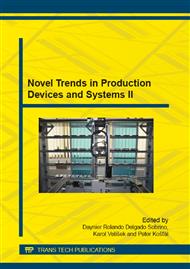[1]
L. Bossidy, R. Charan, Realise Process Management. Management Press, Praha, 2004. ISBN 80-7261-118-6.
Google Scholar
[2]
M. Imai, Kaizen - Method How to Implement an Economy and a More Flexible Production in Organisation. Computer Press, Brno, 2008. ISBN 978-80-251-1621-0.
Google Scholar
[3]
M. Imai, Gemba Kaizen. Computer Press, Brno, 2008. ISBN 80-251-0850-3.
Google Scholar
[4]
I. Kratochvíl, V. Cílek, About the Nature, the Management and the Hope on Concrete. Alfa Publishing, Praha, 2005. ISBN 80-86851-21-4.
Google Scholar
[5]
H. Simon, Secrete Champions of the 21 st Century. Management Press, Praha, 2010. ISBN 978-80-7261-225-3.
Google Scholar
[6]
F.J. Studnička, J.J. Kořán, O. Feistmantel, K. Borovský et al., The Otto Encyclopaedia. Part 5. (C-Č). Paseka, Praha, 1997. ISBN 80-7185-102-7.
Google Scholar
[7]
L. Vodáček, O. Vodáčková, Modern Management in Theory and Practice. Management Press, Praha, 2009. ISBN 978-80-7261-197-3.
Google Scholar
[8]
Norm EN 60300-2: (2004).
Google Scholar
[2005]
Reliability Management - Part 2: Recommendation for Reliability Management. ČNI, Praha.
Google Scholar
[9]
Norm ISO9001: (2008).
Google Scholar
[2009]
Quality Management System. ÚNMZ, Praha. Reference to a chapter in an edited book.
Google Scholar
[10]
Authors, Tools for Life-cycle Management of Product. CAD. [online]. [cit. 2014-05-17] ISSN 1802-6168. Information on: <http: /www. cad. cz/strojirenstvi/38-strojirenstvi/1472-nastroje-pro-rizeni-zivotniho-cyklu-vyrobku. html>.
Google Scholar
[11]
J. Devát, Začíná třetí průmyslová revoluce. Ve 3D. Text. [online]. In. Hospodářské noviny IHNED, 2014. Economia, a. s. ISSN 1213-7693. [cit. 2014-05-17] Information on: <http: /ekonom. ihned. cz/c1-61658150-komentar-jiriho-devata-zacina-treti-prumyslova-revoluce-ve-3d>.
Google Scholar
[12]
T. Görner, M. Šimon, M. Edl, Ergonomie a životní cyklus produktu. [online]. In. Časopis výzkumu a aplikací v profesionální bezpečnosti, 2011, Vol. 4, Issue 3. ISSN 1803-3687. [cit. 2014-05-17] Information on: <http: /www. bozpinfo. cz/josra/josra-03-2011/ergonomie-produkt. html>.
Google Scholar
[13]
S. Kashyap, A Feature-based Framework for Attachment Level Snap-fastener Design in Product Design for Automated Assembly. [online]. In. Assembly and Task Planning, 7/1999, pp.51-56.
DOI: 10.1109/isatp.1999.782934
Google Scholar
[14]
H. Kopecká, Životní cyklus produktu. [online]. In. Marketingové noviny, 2001. [cit. 2014-05-17] Information on: <http: /www. marketingovenoviny. cz>.
Google Scholar
[15]
P. Pernelle, J. Ch. Marty, T. Carron, Serious Gaming: A New Way to Introdukce Product Lifecycle Management. [online]. In. Workshop on Learning Technology for Education in Cloud. Advances in Intelligent System and Computing, 2012, Vol. 173, pp.89-100.
DOI: 10.1007/978-3-642-30859-8_9
Google Scholar
[16]
Z. Pitra, Životní cyklus projektu. [online]. In. Management projektu. BusinessInfo, 2009. [cit. 2014-05-17] Information on: http: /www. businessinfo. cz/cs/clanky/management-zivostni-cyklus-projektu-2786. html>.
Google Scholar
[17]
R. Schmidt, A. Ottong, H. Gut, Mitigating Technical Risks by Creative Problem Solving Approaches. In. Reliability and Maintainability Symposium, 2011, Proceedings – Annual, 1/2011, pp.1-6. ISSN 0149-144X. DOI: 10. 1109/RAMS. 2011. 5754465.
DOI: 10.1109/rams.2011.5754465
Google Scholar
[18]
E. Solano, S.R. Ranjithan, M.A. Barlaz, E.D. Brill, Life-Cycle-based Solid Waste Management. I. Model Development. [online]. In. Journal of Environmental Engineering, 2002, Vol. 128, Issue 10, p.981.
DOI: 10.1061/(asce)0733-9372(2002)128:10(981)
Google Scholar
[19]
J. Sullivan, M. Costic, W. Han, Automotive Life Cycle Assessment: Overview, Metrics, and Examples. [online]. In. SAE Technical Paper 980467, 2/1998. [cit. 2014-05-17] Information on: <http: /papers. sae. org/980467/>.
DOI: 10.4271/980467
Google Scholar
[20]
J. Vacátko, Životní cyklus řídicích systémů. [online]. In. Automa, 2008, č. 5, FCC Public s. r. o. [cit. 2014-05-17] Information on: <http: /www. odbornecasopisy. cz/index. php?id_dokument=37332>.
Google Scholar
[21]
A. Wardak, M.E. Gorman, N. Swami, S. Deshpande, Identification of Risks in the Life Cycle of Nanotechnology-Based Products. [online]. In. Journal of Industrial Ecology, 2008, Vol. 12, Issue 3, pp.435-448.
DOI: 10.1111/j.1530-9290.2008.00029.x
Google Scholar


